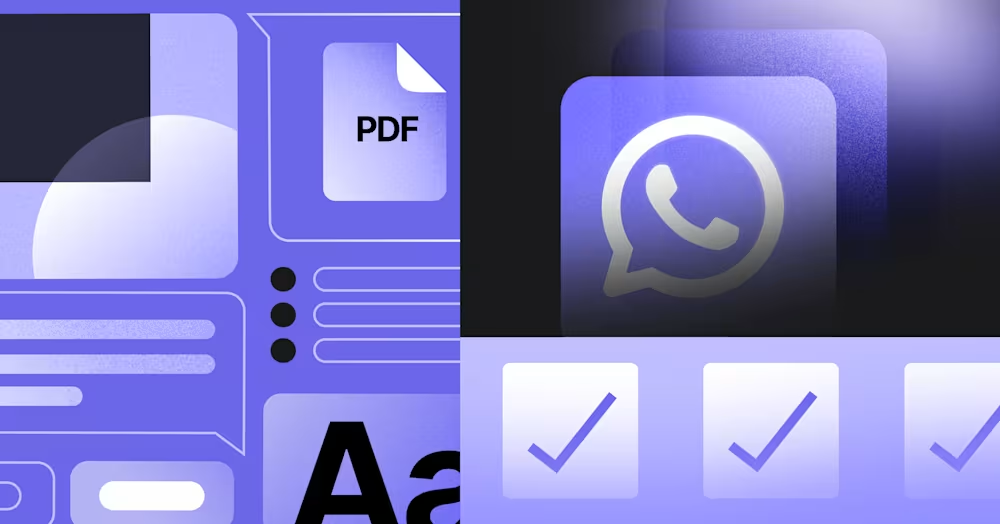
Modelo de mensagem do WhatsApp: um guia prático com 13 exemplos
As empresas não podem enviar mensagens do WhatsApp após 24 horas, a menos que usem o Modelo de Mensagem do WhatsApp. Aprenda a formatar e enviar mensagens de modelo, além de exemplos.
![Plataforma de Comunicação Omnichannel: Tudo o que você precisa saber [Julho de 2023]](https://assets2-proxy.respond.io/ph8r57dk1q9w/6H24gSq29rc35FmX7d3Ol1/2563e8bef2a0eba0053bf4e4a59d7fcb/OmnichannelCommunicationCoverImage02_Image04_a39b0f08915b8e88afbf61f738be3239.png?q=70&fm=avif)
Curioso sobre o que é comunicação omnichannel ou o que uma plataforma de comunicação omnichannel faz? Então este blog é para você! Vamos explicar tudo o que você precisa saber sobre comunicação omnichannel e como uma plataforma como a respond.io pode ajudar seu negócio.
Comunicação omnichannel é uma estratégia onde um negócio utiliza diferentes canais para se conectar com os clientes, enquanto oferece uma experiência consistente ao cliente em cada ponto de contato.
Essa estratégia pode ser executada em canais offline, como lojas físicas, e canais online, como chat na web, canais de mensagens e muito mais. Aqui está um exemplo de como a comunicação omnichannel pode parecer.
Um cliente procurando um traje da Mulher Maravilha encontra seu site através da busca do Google. Ele conversa com um agente pelo chat na web para agendar um encaixe e depois compra o traje na loja, onde é convidado a seguir sua página no Instagram para obter um desconto.
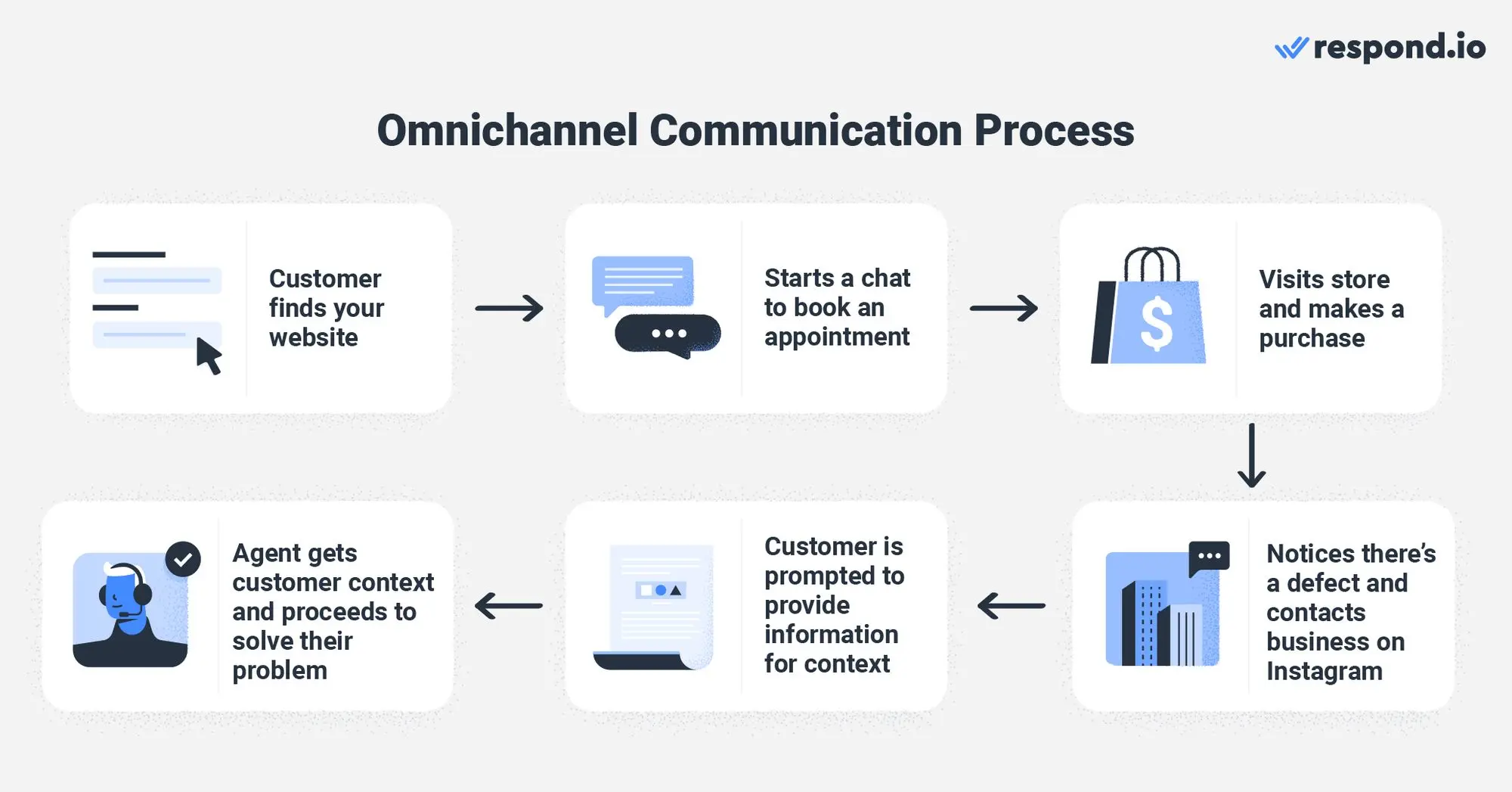
Quando percebe que há um defeito no traje, ele envia uma mensagem para a empresa no Instagram, onde é solicitado a fornecer seus dados pessoais e o problema que está enfrentando. O agente obtém o contexto do cliente e o ajuda com seu problema.
Do exemplo, você verá que o cliente transita naturalmente entre canais online e offline.
Embora o conceito de comunicação omnichannel seja relativamente novo na indústria, muitos o confundem com a comunicação multicanal. Para ajudá-lo a entender as diferenças, vamos explorar ambas as estratégias na próxima seção.
Comunicação omnichannel e comunicação multicanal têm objetivos e benefícios diferentes em mente. Uma estratégia de comunicação multicanal simplesmente significa que uma empresa está utilizando múltiplos canais de comunicação.
Seu foco principal é ter uma presença onde quer que os clientes estejam. Os canais envolvidos funcionam individualmente e estão desconectados. Por essa razão, os clientes não conseguem continuar uma conversa ou se mover de um canal para o próximo com facilidade.
Recurso | Comunicação Omnichannel | Comunicação Multicanal |
|---|---|---|
Objetivo | Fornecer uma experiência consistente ao cliente em todos os canais (Centrada no cliente) | Ter uma presença onde quer que os clientes estejam (Centrada no canal) |
Estratégia | Foca na experiência do cliente | Foca no engajamento do canal |
Características | • Envolve múltiplos canais que os clientes utilizam | • Envolve múltiplos canais que os clientes utilizam |
Uma estratégia de comunicação omnichannel, por outro lado, significa que você tem múltiplos canais de comunicação que estão conectados. Essa abordagem é mais centrada no cliente, pois foca em fornecer uma experiência consistente ao cliente em cada ponto de contato.
Uma estratégia de comunicação omnichannel bem-sucedida envolve uma compreensão profunda das necessidades dos clientes, combinada com uma plataforma que ajude as empresas a acessar contextos e mais. Vamos discutir mais sobre isso depois.
Para resumir, ambas as estratégias fornecem múltiplos pontos de contato para os clientes. Mas a estratégia de comunicação omnichannel conecta todos os canais e elimina as lacunas de comunicação que vêm com uma estratégia multicanal.
Transforme conversas com clientes em crescimento para os negócios com a respond.io. ✨
Gerencie chamadas, chats e e-mails em um só lugar!
Os consumidores de hoje usam múltiplos canais ao longo de seus ciclos de vida. Eles podem navegar pelos seus produtos na Loja do Facebook, te seguir no Instagram para atualizações e preferir conversar ou fazer chamadas pelo WhatsApp.
Embora seja fácil estar disponível em vários canais, 90% dos clientes querem um serviço omnichannel.
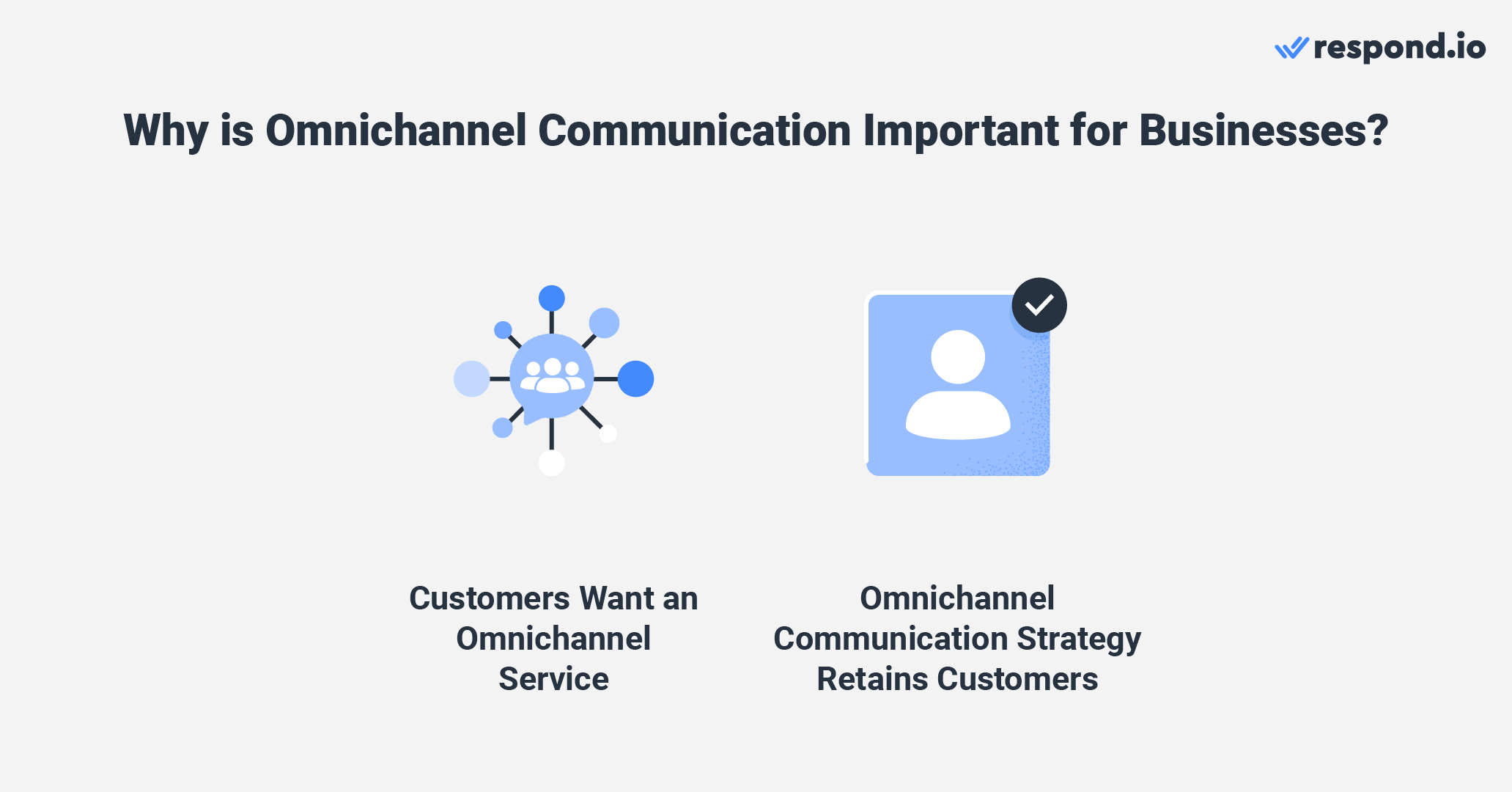
Também está comprovado que empresas com estratégias omnichannel eficazes retêm 89% de seus clientes em comparação à taxa de retenção de 33% para empresas com um fraco engajamento de clientes omnichannel.
Entendendo isso, o número de empresas que investem na experiência omnichannel cresceu 60% de 2012 a 2020. Agora vamos ver como a comunicação omnichannel beneficia os negócios que utilizam múltiplos canais.
Os clientes querem uma frente unida de representantes da empresa que estejam equipados com o mesmo contexto e informação. De fato, 65% dos clientes esperam que todos os representantes da empresa tenham as mesmas informações sobre eles.
Isso é especialmente verdadeiro porque os clientes não gostam de precisar se reidentificar e repetir suas preocupações em cada canal. Portanto, as empresas precisam ter uma visão completa da jornada do cliente para ter uma estratégia de comunicação omnichannel bem-sucedida.
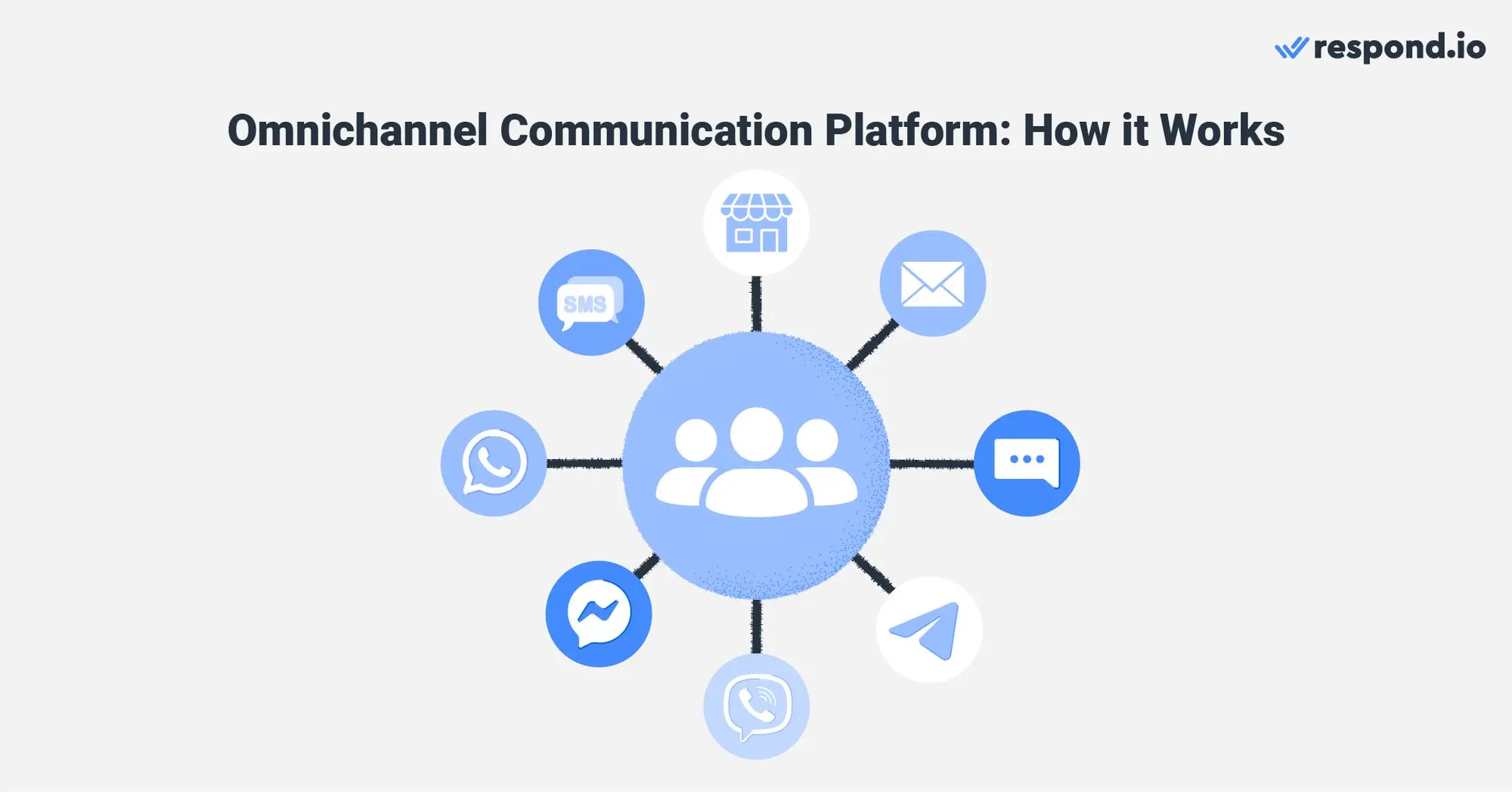
Você precisa consolidar as informações dos clientes, como dados pessoais e histórico de conversas, em uma única plataforma para fornecer uma experiência suave e consistente. É aqui que uma plataforma de comunicação omnichannel entra.
Uma plataforma de comunicação omnichannel fornece às empresas uma fonte única de verdade para informações do cliente, conectando vários canais em uma única plataforma. Isso fornece insights valiosos sobre a jornada do cliente para uma experiência consistente.
Para manter uma experiência consistente ao cliente, todas as equipes que atendem os clientes devem se comunicar de acordo com os valores e tom da sua marca. Enquanto as empresas podem criar guias de mensagens e templates para refletir isso, personalizá-los manualmente pode ser cansativo.
Felizmente, com a ajuda de uma plataforma de comunicação omnichannel, você pode padronizar suas mensagens em todos os canais usando respostas pré-configuradas que são acessíveis com um clique. Essas respostas são automaticamente personalizadas.
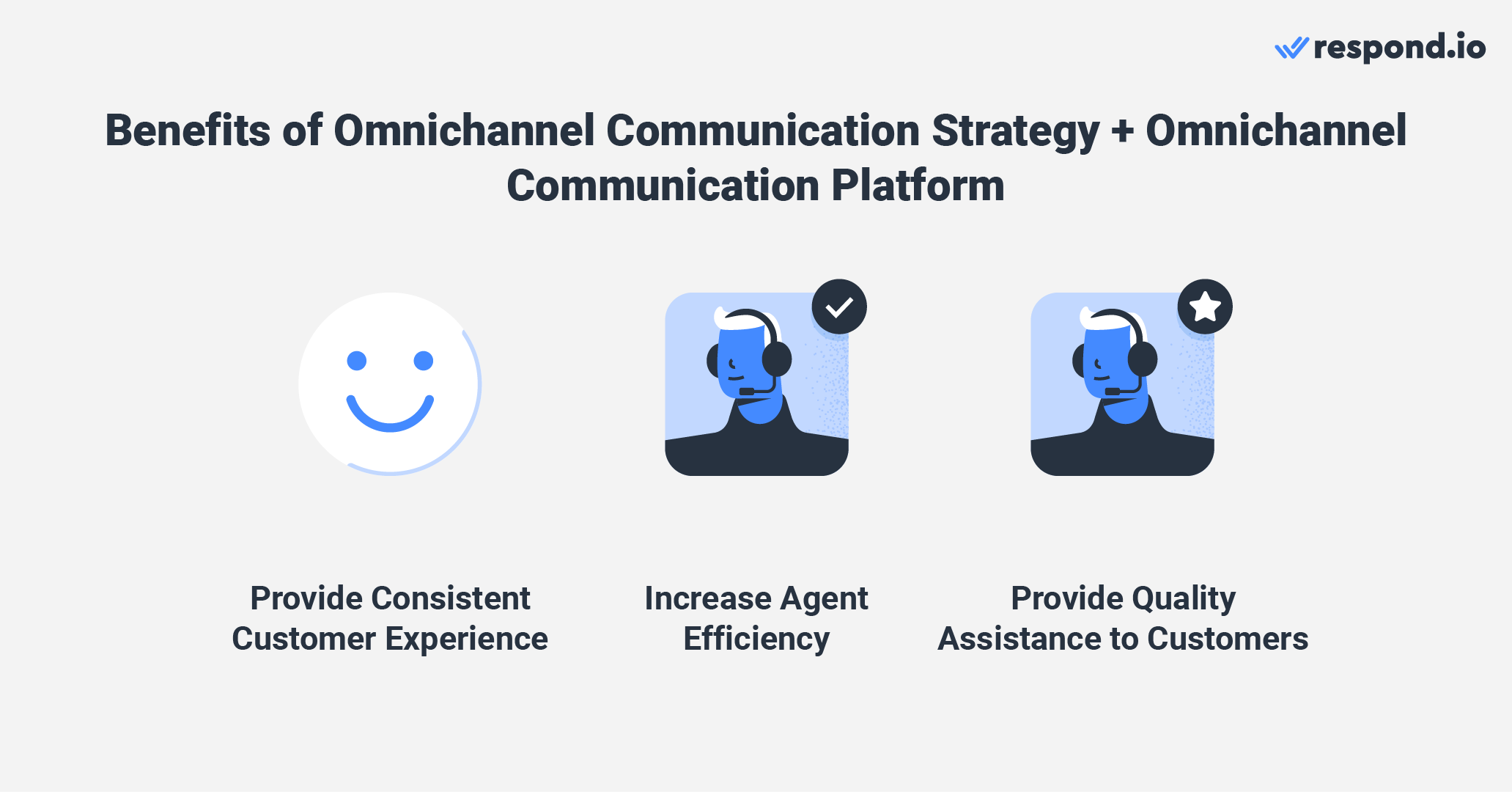
Não só isso, mas como todos os canais estão conectados a uma plataforma, você pode executar sua estratégia simultaneamente em cada canal. Como resultado, você pode fornecer uma experiência consistente ao cliente, enquanto ajuda os agentes a trabalharem de forma mais eficiente para fornecer assistência de alta qualidade.
Em sua forma mais básica, um sistema de comunicação omnichannel deve permitir que você:
Integre múltiplos canais, suportando todos os recursos dos canais
Responda aos clientes, independentemente do canal, a partir de uma única plataforma
Automatize tarefas simples, como respostas rápidas que funcionam em todos os canais
Se você está procurando uma plataforma de comunicação omnichannel que suporte todos os recursos acima e mais, sugerimos que experimente a respond.io.
Agora que você sabe tudo sobre comunicação omnichannel, vamos ver como a respond.io pode ajudar na sua estratégia de comunicação omnichannel.
A respond.io é uma plataforma de comunicação omnichannel que permite a você otimizar a comunicação comercial em aplicativos de mensagens instantâneas, juntamente com canais tradicionais como e-mail e chat na web.
Ela suporta todos os aplicativos de mensagens populares, incluindo WhatsApp, Facebook Messenger, LINE e Viber, e possui um widget de chat omnichannel para todos eles. Ela também possui um gerador de QR code para trazer clientes e leads de lojas físicas para sua caixa de mensagens.
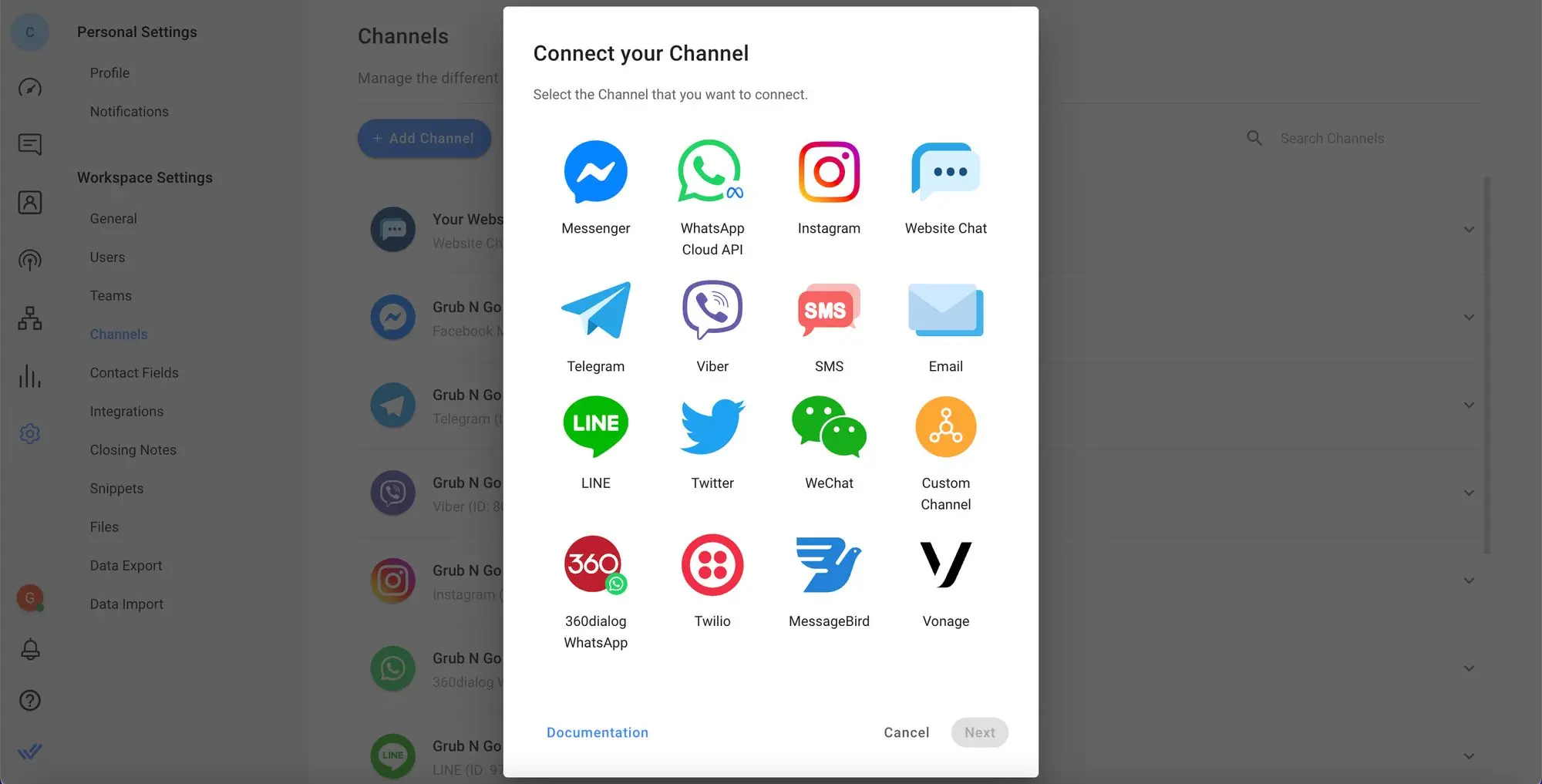
As empresas podem até conectar canais personalizados e seus CRMs com a respond.io. Isso permitirá que elas troquem informações entre quaisquer canais de mensagens com seus CRMs ou canais personalizados.
Por exemplo, você pode atualizar dados de clientes em CRMs e na respond.io simultaneamente, e criar negócios ou tickets de suporte enquanto conversa com clientes, para registrar esses eventos em ambas as plataformas como parte de uma história consistente do cliente.
Como mencionado anteriormente, os clientes tentarão entrar em contato com as empresas através de vários canais e esperam que as empresas conheçam seu histórico de conversas anterior, não importando quais canais suas conversas passadas ocorreram.
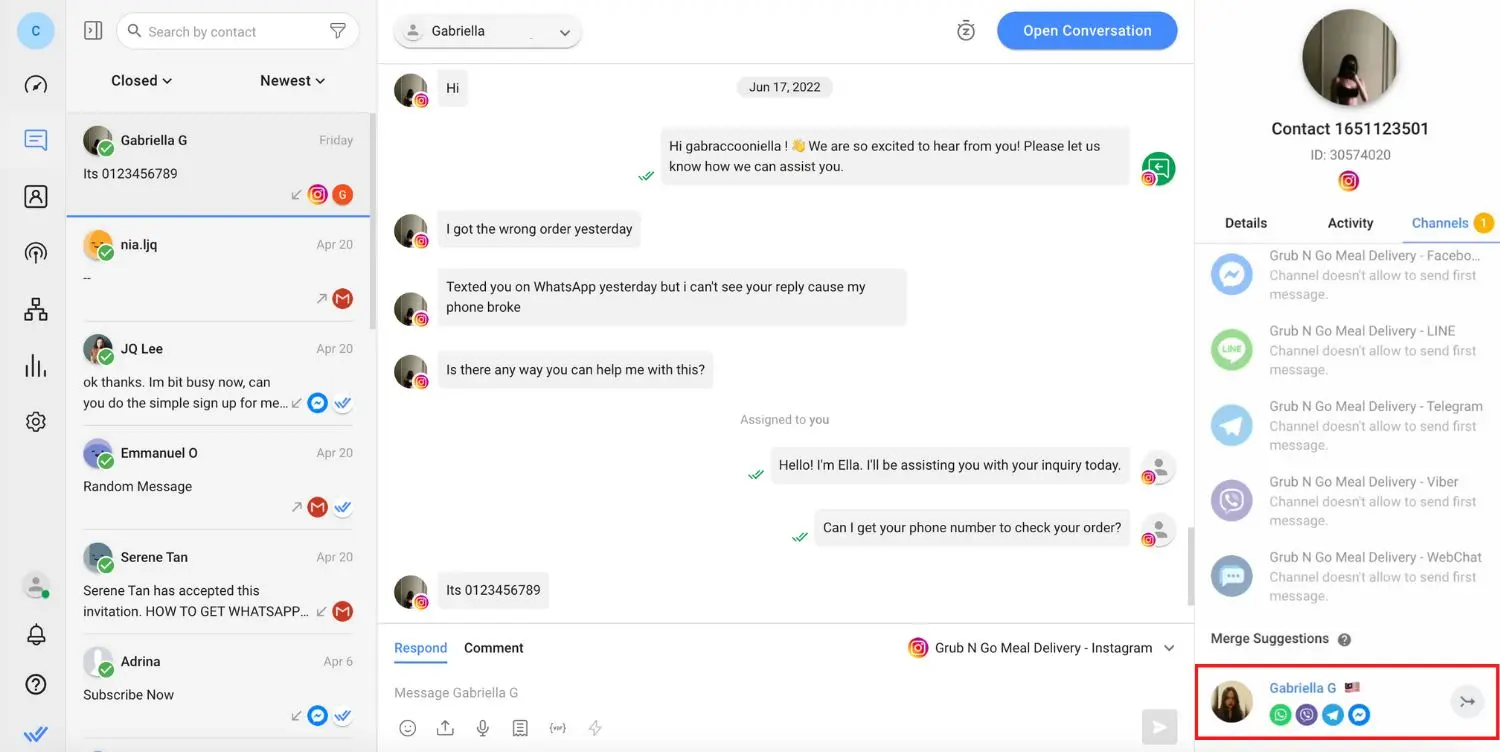
Para ajudá-lo a obter uma visão abrangente de um cliente, a respond.io permite que você mescle todos os detalhes de contato e o histórico de conversas entre canais em um perfil unificado. Dessa forma, a conversa de um cliente ficará em um único fio, evitando conversas isoladas.
Ela também permite que os clientes continuem uma conversa de um canal para outro sem precisar repetir informações de fundo. Isso ajudará os agentes a entenderem o contexto dos clientes imediatamente e escolher a maneira mais eficaz de ajudá-los.
A respond.io tem todas as ferramentas que você precisa para realizar marketing, vendas e suporte em várias canais. Para marketing, as empresas podem usar a ferramenta de transmissão da respond.io, que permite segmentar contatos em diferentes públicos para enviar mensagens de broadcast direcionadas.
Você pode enviar transmissões em canais como WhatsApp, Facebook Messenger e Viber, com diferentes tipos de conteúdos como imagens, vídeos e mais. A respond.io também permite padronizar mensagens 1:1 em todos os canais com respostas pré-configuradas.
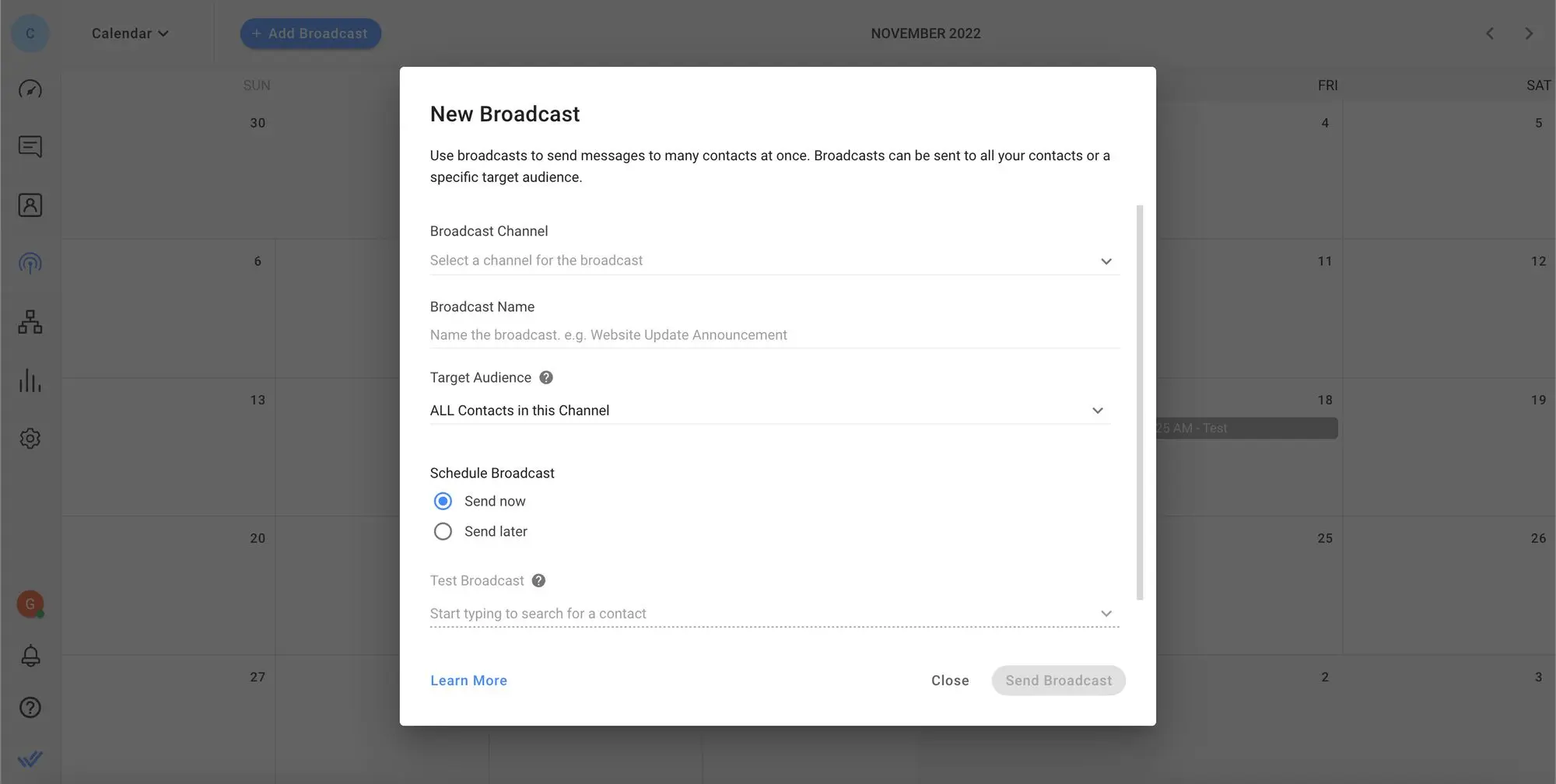
Além disso, as empresas podem automatizar tarefas repetitivas de vendas e suporte com Modelos de Workflow ou construir Workflows do zero. Isso inclui automação para qualificação de leads, responder dúvidas frequentes, rotear e atribuir clientes e mais.
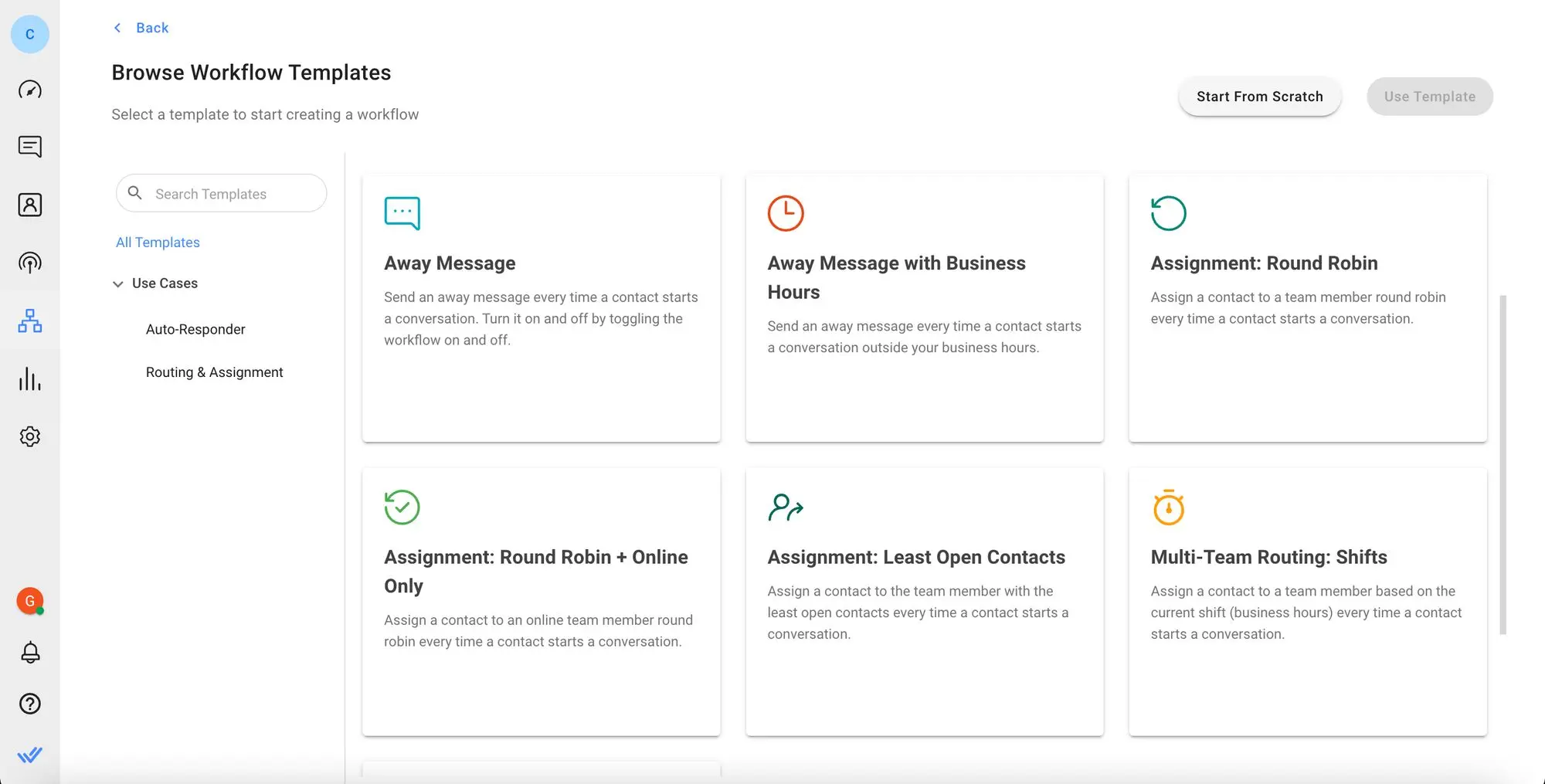
Além disso, as empresas podem medir o sucesso e a qualidade do suporte ao cliente enviando uma pesquisa de satisfação do cliente (CSAT) ou acompanhando o desempenho individual ou da equipe.
As empresas podem usar os Relatórios e Análises do respond.io para acompanhar a carga de trabalho e produtividade dos agentes, o progresso das conversas e o tempo de resolução. O painel de supervisores permite que os gerentes identifiquem conversas que foram deixadas em espera ou não resolvidas por muito tempo e monitorem os agentes em tempo real.
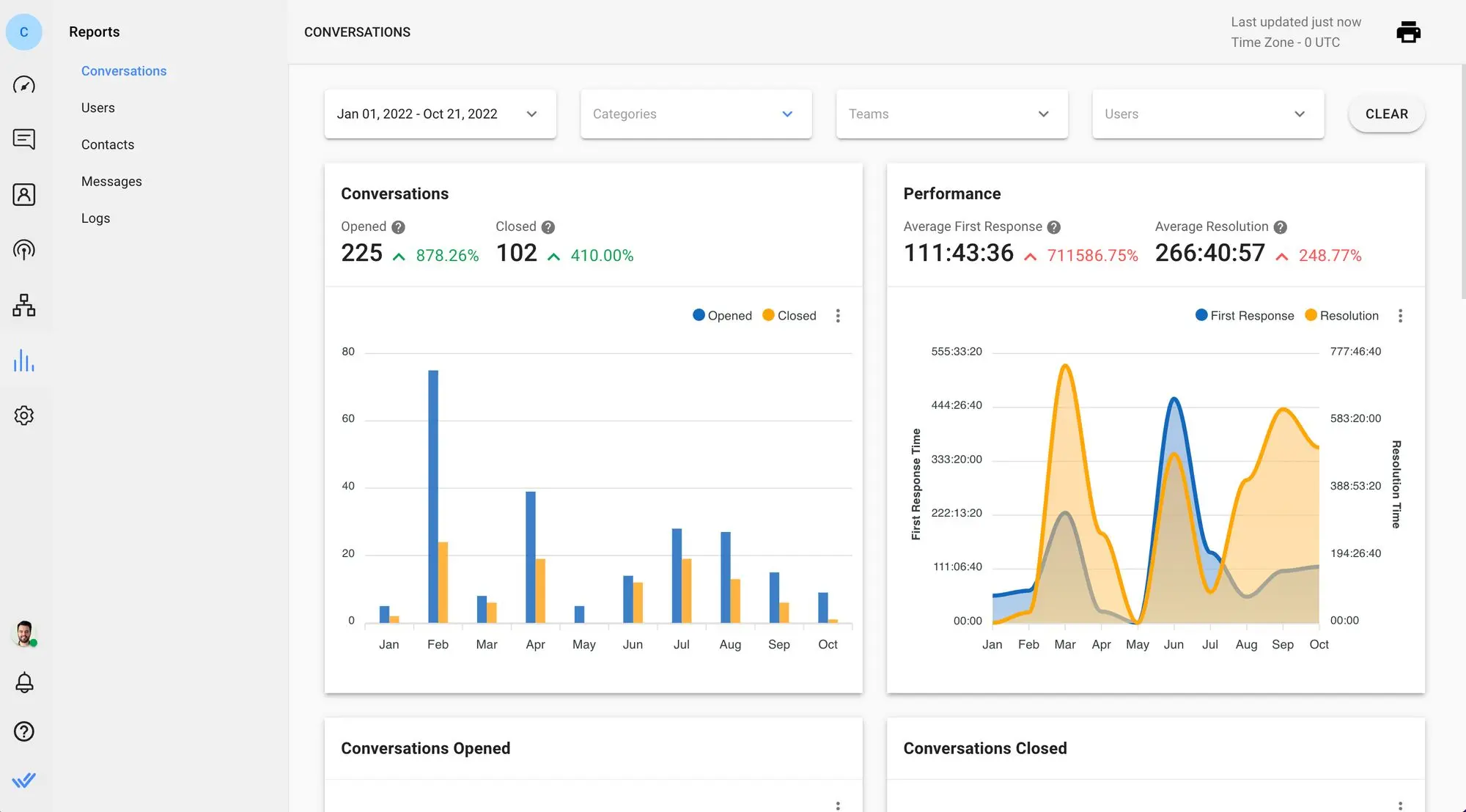
Os gerentes podem ver a eficiência de suas equipes, analisar as áreas em que estão com dificuldade e trabalhar para melhorar seu desempenho. Por fim, eles podem executar todas as suas tarefas em qualquer lugar com o aplicativo móvel do respond.io. Está disponível na Google Play Store para Android e Apple App Store para iOS.
Transforme conversas com clientes em crescimento dos negócios com o respond.io. ✨
Gerencie chamadas, chats e emails em um só lugar!
Precisa de inspiração para iniciar sua jornada de comunicação omnicanal? Dê uma olhada nas histórias de sucesso de nossos clientes!
Gabriella é redatora de conteúdo na respond.io, especializada como autoridade da equipe para o WhatsApp desde 2022. Formada em Comunicação, Gabriella aprimorou suas habilidades como especialista em marketing em uma empresa de hospedagem de sites. Seu profundo conhecimento em aplicativos de mensagens, na indústria de SaaS e no comportamento do cliente torna seus artigos guias indispensáveis para negócios adeptos da tecnologia.

As empresas não podem enviar mensagens do WhatsApp após 24 horas, a menos que usem o Modelo de Mensagem do WhatsApp. Aprenda a formatar e enviar mensagens de modelo, além de exemplos.